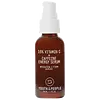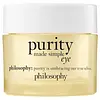What's inside
What's inside
 Key Ingredients
Key Ingredients

 Benefits
Benefits

 Concerns
Concerns

 Ingredients Side-by-side
Ingredients Side-by-side

Water
Skin Conditioning3-O-Ethyl Ascorbic Acid
Skin ConditioningTetrahexyldecyl Ascorbate
AntioxidantPropanediol
SolventGlycerin
HumectantPentylene Glycol
Skin ConditioningSodium Citrate
BufferingSqualane
EmollientTriethyl Citrate
MaskingGluconolactone
Skin ConditioningCitric Acid
BufferingPolyhydroxystearic Acid
EmulsifyingPolyglyceryl-6 Polyricinoleate
EmulsifyingXanthan Gum
EmulsifyingSodium Hyaluronate
HumectantCaffeine
Skin ConditioningMagnesium Ascorbyl Phosphate
AntioxidantSodium Stearoyl Glutamate
CleansingSodium Benzoate
MaskingLauroyl Lysine
Skin ConditioningPassiflora Edulis Fruit Extract
Skin ConditioningSclerotium Gum
Emulsion StabilisingLecithin
EmollientIlex Guayusa Leaf Extract
Skin ProtectingIlex Paraguariensis Leaf Extract
PerfumingPullulan
Mannitol
HumectantHylocereus Undatus Fruit Extract
Skin ConditioningZingiber Officinale Root Oil
MaskingCalcium Gluconate
HumectantSilica
AbrasivePotassium Sorbate
PreservativePhenoxyethanol
PreservativeErgothioneine
AntioxidantWater, 3-O-Ethyl Ascorbic Acid, Tetrahexyldecyl Ascorbate, Propanediol, Glycerin, Pentylene Glycol, Sodium Citrate, Squalane, Triethyl Citrate, Gluconolactone, Citric Acid, Polyhydroxystearic Acid, Polyglyceryl-6 Polyricinoleate, Xanthan Gum, Sodium Hyaluronate, Caffeine, Magnesium Ascorbyl Phosphate, Sodium Stearoyl Glutamate, Sodium Benzoate, Lauroyl Lysine, Passiflora Edulis Fruit Extract, Sclerotium Gum, Lecithin, Ilex Guayusa Leaf Extract, Ilex Paraguariensis Leaf Extract, Pullulan, Mannitol, Hylocereus Undatus Fruit Extract, Zingiber Officinale Root Oil, Calcium Gluconate, Silica, Potassium Sorbate, Phenoxyethanol, Ergothioneine
Water
Skin ConditioningGlycerin
HumectantCaprylic/Capric Triglyceride
MaskingButylene Glycol
HumectantPEG-240/Hdi Copolymer Bis-Decyltetradeceth-20 Ether
StabilisingLimnanthes Alba Seed Oil
Skin ConditioningPolyglyceryl-2 Diisostearate
EmulsifyingPolysorbate 20
EmulsifyingButyrospermum Parkii Butter Extract
Skin ConditioningPhenoxyethanol
PreservativeOlea Europaea Fruit Oil
MaskingTocopheryl Acetate
AntioxidantBisabolol
MaskingCetearyl Olivate
Cyclopentasiloxane
EmollientSorbitan Olivate
EmulsifyingCaffeine
Skin ConditioningPanthenol
Skin ConditioningPropylene Glycol
HumectantCreatine
Skin ConditioningDimethiconol
EmollientSalvia Hispanica Seed Oil
MoisturisingAcrylates/C10-30 Alkyl Acrylate Crosspolymer
Emulsion StabilisingPEG-8
HumectantLecithin
EmollientCyclohexasiloxane
EmollientHydrogenated Lecithin
EmulsifyingAscorbyl Glucoside
AntioxidantBHT
AntioxidantDisodium EDTA
Ginkgo Biloba Leaf Extract
Skin ConditioningSodium Hydroxide
BufferingTocopherol
AntioxidantAesculus Hippocastanum Seed Extract
Skin ConditioningGlucose
HumectantLactic Acid
BufferingChlorphenesin
AntimicrobialAlcohol Denat.
AntimicrobialAscorbyl Palmitate
AntioxidantPantolactone
HumectantPotassium Sorbate
PreservativeCamellia Sinensis Leaf Extract
AntimicrobialCoffea Arabica Seed Extract
MaskingPongamia Pinnata Seed Extract
Skin ConditioningSorbic Acid
PreservativeCitric Acid
BufferingAscorbic Acid
AntioxidantSodium Benzoate
MaskingAngelica Archangelica Root Extract
MaskingCitrus Aurantium Amara Peel Extract
MaskingMaltodextrin
AbsorbentPolyglyceryl-3 Diisostearate
EmulsifyingMagnesium Aluminum Silicate
AbsorbentXanthan Gum
EmulsifyingFarnesol
PerfumingCaprylyl Glycol
EmollientSclerotium Gum
Emulsion StabilisingCI 19140
Cosmetic ColorantWater, Glycerin, Caprylic/Capric Triglyceride, Butylene Glycol, PEG-240/Hdi Copolymer Bis-Decyltetradeceth-20 Ether, Limnanthes Alba Seed Oil, Polyglyceryl-2 Diisostearate, Polysorbate 20, Butyrospermum Parkii Butter Extract, Phenoxyethanol, Olea Europaea Fruit Oil, Tocopheryl Acetate, Bisabolol, Cetearyl Olivate, Cyclopentasiloxane, Sorbitan Olivate, Caffeine, Panthenol, Propylene Glycol, Creatine, Dimethiconol, Salvia Hispanica Seed Oil, Acrylates/C10-30 Alkyl Acrylate Crosspolymer, PEG-8, Lecithin, Cyclohexasiloxane, Hydrogenated Lecithin, Ascorbyl Glucoside, BHT, Disodium EDTA, Ginkgo Biloba Leaf Extract, Sodium Hydroxide, Tocopherol, Aesculus Hippocastanum Seed Extract, Glucose, Lactic Acid, Chlorphenesin, Alcohol Denat., Ascorbyl Palmitate, Pantolactone, Potassium Sorbate, Camellia Sinensis Leaf Extract, Coffea Arabica Seed Extract, Pongamia Pinnata Seed Extract, Sorbic Acid, Citric Acid, Ascorbic Acid, Sodium Benzoate, Angelica Archangelica Root Extract, Citrus Aurantium Amara Peel Extract, Maltodextrin, Polyglyceryl-3 Diisostearate, Magnesium Aluminum Silicate, Xanthan Gum, Farnesol, Caprylyl Glycol, Sclerotium Gum, CI 19140
 Reviews
Reviews

Ingredients Explained
These ingredients are found in both products.
Ingredients higher up in an ingredient list are typically present in a larger amount.
Caffeine is most associated with coffee, tea, and cacao. In skincare, it helps with calming inflammation and is rich in antioxidants.
While caffeine is used to treat cellulite and and dark circles, further studies are needed to prove this. It has been believed to help with these skin conditions due to its ability to dilate blood vessels and increase blood flow.
Some studies are looking into caffeine's ability to protect against UV rays.
Learn more about CaffeineCitric Acid is an alpha hydroxy acid (AHA) naturally found in citrus fruits like oranges, lemons, and limes.
Like other AHAs, citric acid can exfoliate skin by breaking down the bonds that hold dead skin cells together. This helps reveal smoother and brighter skin underneath.
However, this exfoliating effect only happens at high concentrations (20%) which can be hard to find in cosmetic products.
Due to this, citric acid is usually included in small amounts as a pH adjuster. This helps keep products slightly more acidic and compatible with skin's natural pH.
In skincare formulas, citric acid can:
While it can provide some skin benefits, research shows lactic acid and glycolic acid are generally more effective and less irritating exfoliants.
Most citric acid used in skincare today is made by fermenting sugars (usually from molasses). This synthetic version is identical to the natural citrus form but easier to stabilize and use in formulations.
Read more about some other popular AHA's here:
Learn more about Citric AcidGlycerin is already naturally found in your skin. It helps moisturize and protect your skin.
A study from 2016 found glycerin to be more effective as a humectant than AHAs and hyaluronic acid.
As a humectant, it helps the skin stay hydrated by pulling moisture to your skin. The low molecular weight of glycerin allows it to pull moisture into the deeper layers of your skin.
Hydrated skin improves your skin barrier; Your skin barrier helps protect against irritants and bacteria.
Glycerin has also been found to have antimicrobial and antiviral properties. Due to these properties, glycerin is often used in wound and burn treatments.
In cosmetics, glycerin is usually derived from plants such as soybean or palm. However, it can also be sourced from animals, such as tallow or animal fat.
This ingredient is organic, colorless, odorless, and non-toxic.
Glycerin is the name for this ingredient in American English. British English uses Glycerol/Glycerine.
Learn more about GlycerinLecithin is a term for a group of substances found in the cell membranes of plants, animals, and humans. They are made up of mixture of phospholipids.
This ingredient has emollient and emulsifying properties.
As an emollient, lecithen helps soften the skin and creates a barrier to keep moisture in.
As an emulsifier, it also helps prevent water and oil ingredients from separating. Lecithin can also help ingredients be better absorbed by the skin.
This is because the phospholipids in lecithin produce liposomes. Liposomes help other ingredients get through the skin barrier.
Depending on the source of this ingredient, lecithin may not be fungal acne safe. This is because some sources of lecithin come from soybean oil, which may feed the malassezia yeast that feeds fungal acne.
We recommend reaching out to the brand you are purchasing from to inquire about the source of their lecithin.
Some other names for this ingredient include soy lecithin and deoiled soy lecithin.
Learn more about LecithinPhenoxyethanol is a preservative that has germicide, antimicrobial, and aromatic properties. Studies show that phenoxyethanol can prevent microbial growth. By itself, it has a scent that is similar to that of a rose.
It's often used in formulations along with Caprylyl Glycol to preserve the shelf life of products.
Potassium Sorbate is a preservative used to prevent yeast and mold in products. It is commonly found in both cosmetic and food products.
This ingredient comes from potassium salt derived from sorbic acid. Sorbic acid is a natural antibiotic and effective against fungus.
Both potassium sorbate and sorbic acid can be found in baked goods, cheeses, dried meats, dried fruit, ice cream, pickles, wine, yogurt, and more.
You'll often find this ingredient used with other preservatives.
Learn more about Potassium SorbateSclerotium Gum is a polysaccharide gum made by the fungus, Sclerotium rolfssii. It is similar to xanthan gum.
In cosmetics, Sclerotium Gum is used to thicken the texture and to help stabilize other ingredients.
As an emulsifier, Sclerotium Gum helps prevent ingredients from separating, such as water and oil.
Learn more about Sclerotium GumSodium Benzoate is a preservative. It's used in both cosmetic and food products to inhibit the growth of mold and bacteria. It is typically produced synthetically.
Both the US FDA and EU Health Committee have approved the use of sodium benzoate. In the US, levels of 0.1% (of the total product) are allowed.
Sodium benzoate works as a preservative by inhibiting the growth of bacteria inside of cells. It prevents the cell from fermenting a type of sugar using an enzyme called phosphofructokinase.
It is the salt of benzoic acid. Foods containing sodium benzoate include soda, salad dressings, condiments, fruit juices, wines, and snack foods.
Studies for using ascorbic acid and sodium benzoate in cosmetics are lacking, especially in skincare routines with multiple steps.
We always recommend speaking with a professional, such as a dermatologist, if you have any concerns.
Learn more about Sodium BenzoateWater. It's the most common cosmetic ingredient of all. You'll usually see it at the top of ingredient lists, meaning that it makes up the largest part of the product.
So why is it so popular? Water most often acts as a solvent - this means that it helps dissolve other ingredients into the formulation.
You'll also recognize water as that liquid we all need to stay alive. If you see this, drink a glass of water. Stay hydrated!
Learn more about WaterXanthan gum is used as a stabilizer and thickener within cosmetic products. It helps give products a sticky, thick feeling - preventing them from being too runny.
On the technical side of things, xanthan gum is a polysaccharide - a combination consisting of multiple sugar molecules bonded together.
Xanthan gum is a pretty common and great ingredient. It is a natural, non-toxic, non-irritating ingredient that is also commonly used in food products.
Learn more about Xanthan Gum